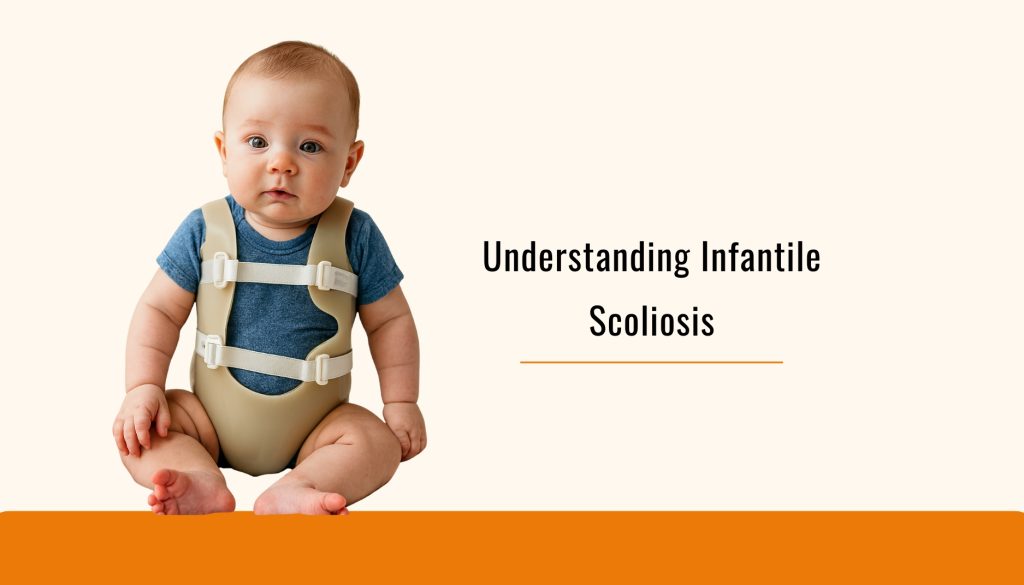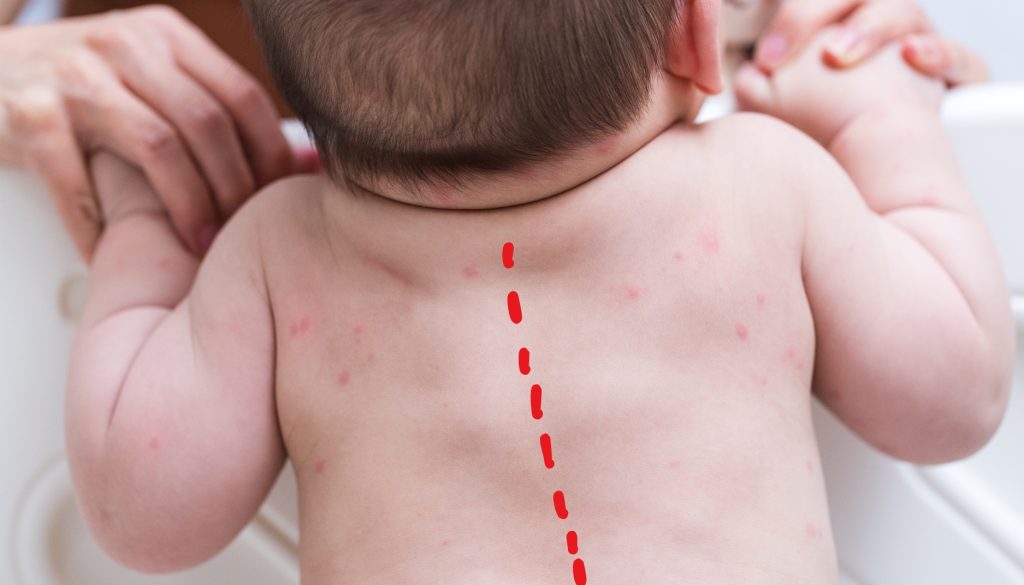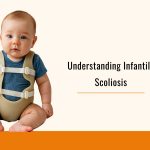
Scoliosis is often associated with adolescence, but in some cases, it begins much earlier. Infantile scoliosis is a rare condition diagnosed in babies and toddlers, typically before age three. While uncommon, it requires careful evaluation and timely management to prevent long-term complications.
Scoliosis is often associated with adolescence, but in some cases, it begins much earlier. Infantile scoliosis is a rare condition diagnosed in babies and toddlers, typically before age three. While uncommon, it requires careful evaluation and timely management to prevent long-term complications.
What Is Infantile Scoliosis?
Infantile scoliosis is a sideways spine curvature that develops in babies and young children. Unlike postural issues, this curvature is structural and often visible on medical imaging.
The term “scoliosis” comes from the Greek word skolios, meaning “crooked.” In infantile cases, the spine curves in either a “C” or “S” shape. It is most often detected between six months and three years of age.
Although the condition is relatively rare, accounting for less than 1% of all scoliosis cases, it can have significant consequences if left untreated, including lung development problems and spinal deformities.
What Causes Scoliosis in Babies?
The causes of scoliosis in toddlers and infants are not always clear. The condition is often termed “idiopathic,” meaning no definitive cause is identified. However, several factors may contribute:
- Genetic predisposition – having a family history of spinal deformities may increase risk.
- Neuromuscular conditions – cerebral palsy or muscular dystrophy can also lead to scoliosis.
- Congenital abnormalities – vertebrae that are abnormally shaped or fused during foetal development.
Environmental influences – though less common, external factors affecting growth may play a role.

Early Signs of Scoliosis in Babies
Parents are often the first to notice signs of spinal curvature. Awareness of the early signs of scoliosis in babies helps ensure timely intervention. Warning signs usually include:
- Uneven shoulders or hips.
- A visible curve in the spine, especially when the baby is sitting.
- Ribs appear more prominent on one side.
- Difficulty lying flat due to spinal asymmetry.
- Limited or unusual movement in one direction.
Since infants cannot describe discomfort, observation is key. Any suspicion of abnormal posture or spinal curvature should prompt a paediatric consultation.
How Is Infantile Scoliosis Diagnosed?
Diagnosis begins with a thorough physical examination. Paediatric orthopaedic specialists often check for spinal symmetry while the child sits, lies, or is gently supported.
Key diagnostic tools include:
- X-rays – to confirm the degree and location of curvature.
- Magnetic Resonance Imaging (MRI) – to rule out spinal cord abnormalities.
- Growth monitoring – tracking changes over time, as some mild curves may resolve naturally with growth.
Doctors use the Cobb angle measurement to quantify curvature. Curves under 20 degrees may be monitored, while larger or progressing curves often require treatment.
.
Infantile Scoliosis: Treatment Options and Outlook
What Determines Infantile Scoliosis Treatment?
Treatment is done based on the degree of spinal curve and the child’s age:
- Mild (≤30 degrees)
- Often monitored with regular check-ups and imaging.
- Many cases improve or stabilise as the child grows.
- Moderate (30–50 degrees)
- Managed with bracing or casting.
- Non-invasive but requires consistent follow-up.
- Severe (≥50 degrees)
- May begin with bracing or casting.
- Surgery is usually required as the child grows.
Infantile Scoliosis: Treatment Options and Outlook
Management primarily varies with the severity of the curve, the child’s age, and the child’s progress in the condition
1. Observation and Monitoring
The curve may resolve spontaneously in mild cases, especially when the child is very young. Regular check-ups and imaging help ensure no worsening occurs.
2. Casting
- Serial casting is one of the most common approaches for infantile scoliosis treatment. A specialised plaster or fibreglass cast is applied to the child’s torso.
- Traditionally, it is the primary treatment for moderate to severe cases.
- Applied under general anaesthesia every 2–3 months.
- Fully encircles the torso with front and back openings.
- Requires sponge baths only and precautions to prevent overheating.
3. Bracing
- If casting is not possible or once casting is completed, a brace may be used to maintain correction.
- Newer alternative to casting; removable for bathing or illness.
- Worn for ~22 hours per day.
- Features a keyhole opening in the front and straps at the back.
- Avoids repeated anaesthesia compared to casting.
Goal of both methods:
- Halt curve progression.
- Encourage partial or full correction of the curve.
Treatment duration depends on:
- Child’s age.
- Curve severity.
- Response to therapy (checked via X-rays).
4. Surgery
Surgery is reserved for severe or progressive cases not responding to casting or bracing.
Techniques may include:
- Growing rods
- Temporary implants are fixed above and below the curve.
- Lengthened every 6 months by ~1 cm as the child grows.
- Outpatient procedure through a small incision.
- Children usually wear a brace or cast alongside rods.
- After final growth spurt → rods removed → spinal fusion performed for stability.
2. Magnetic Growing Rods (MAGEC System)
- This latest technology is reducing repeat surgeries.
- Implanted rods are lengthened externally with a magnetic controller.
- Minimises the need for repeated incisions and anaesthesia.
3. VEPTR™ Technology (Expandable Titanium Rib)
- Used when scoliosis is linked with underdeveloped chest walls.
- Expands the chest cavity to:
- Allow lungs more room to develop.
- Support spinal straightening.
- The device is adjustable and lengthens as the child grows.
4. Spinal fusion –
Generally delayed until the child is older, as it permanently joins affected vertebrae.
Surgery in infants is considered only when necessary due to its risks and long-term implications.
Long-Term Outlook for Children
- Mild scoliosis → may resolve naturally.
- Moderate cases → often stabilise with bracing/casting.
- Severe cases → modern surgery (rods, VEPTR) can achieve excellent outcomes.
- Key factor: early diagnosis and consistent specialist care.
Most children go on to lead normal, active lives when managed appropriately.
Living with a Baby with Scoliosis
Caring for a baby with scoliosis involves more than medical treatment. Parents play a crucial role in supporting overall well-being:
- Ensure regular follow-up visits with specialists.
- Encourage physical activity suited to the child’s age and treatment plan.
- Provide emotional reassurance, as treatments like casting can be challenging for families.
- Seek support groups or counselling if needed.
Prognosis and Long-Term Outcomes
With early diagnosis and appropriate treatment, many children can achieve excellent outcomes. Some mild cases resolve without intervention, while more complex cases can be managed effectively with casting and, if needed, surgical techniques.
Delaying treatment, however, increases the risk of complications such as:
- Worsening curvature.
- Lung development issues due to restricted chest growth.
- Reduced mobility or discomfort later in life.
Why Choose Xtremity for Infantile Scoliosis Care?
At Xtremity, we understand the unique challenges of diagnosing and managing spinal conditions in very young children. Our approach combines advanced diagnostics, evidence-based treatments, and family-centred care.
Key reasons parents trust us:
- Specialist expertise in paediatric spinal deformities.
- Comprehensive care with non-surgical and surgical options.
- State-of-the-art facilities for safe casting and imaging.
- Personalised treatment plans tailored to each child’s growth and needs.
- Family support programmes to guide parents through every step.
How Xtremity Supports Families
At Xtremity, we focus on family-centred and evidence-based care:
- Specialist paediatric expertise in spinal deformities.
- Tailored treatment plans based on growth and curve progression.
- Advanced casting and bracing technologies to minimise discomfort.
- Cutting-edge surgical options, including MAGEC rods and VEPTR.
- Comprehensive support programmes for parents and caregivers.
Guiding Your Child’s Spine Towards a Healthy Future
Infantile scoliosis may be rare, but if left untreated, it can significantly affect a child’s growth and development. The severity of the curve guides treatment; casting and bracing are usually the first steps for babies and toddlers.
At the same time, surgery with growing rods or VEPTR is considered only in severe or progressive cases. Early detection and consistent monitoring are the most critical factors in successful outcomes.
Book an appointment today if you notice early signs of scoliosis in your baby. At Xtremity, we are dedicated to providing advanced and compassionate care, helping your child grow with a healthy spine and a brighter future.
About Us
Xtremity Prosthetics and Orthotics is a specialized health clinic where treatment is provided by a specialized team which comprises allied health professionals as well as medical professionals giving a multidisciplinary approach towards prosthetic and orthotic rehabilitation care.



